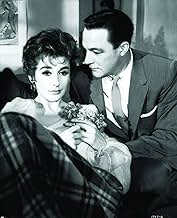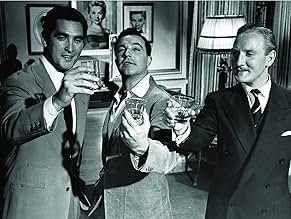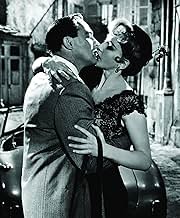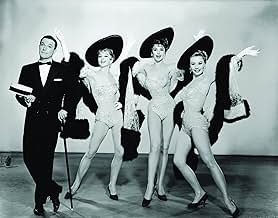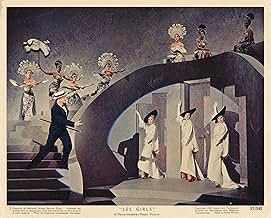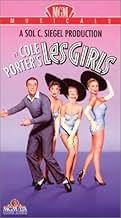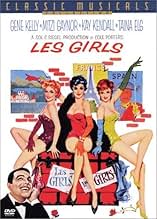IMDb-BEWERTUNG
6,6/10
3239
IHRE BEWERTUNG
Füge eine Handlung in deiner Sprache hinzuThe former members of a dance troupe are suing because of recently published memoirs. Each one insists on own point of view.The former members of a dance troupe are suing because of recently published memoirs. Each one insists on own point of view.The former members of a dance troupe are suing because of recently published memoirs. Each one insists on own point of view.
- 1 Oscar gewonnen
- 7 Gewinne & 7 Nominierungen insgesamt
Richard Alexander
- Stagehand
- (Nicht genannt)
Gordon Armitage
- Courtroom Spectator
- (Nicht genannt)
Frank Arnold
- Taxi Driver
- (Nicht genannt)
Herman Boden
- Angèle's Backup Musician
- (Nicht genannt)
Brad Brown
- Court Barrister
- (Nicht genannt)
Barrie Chase
- Dancer in 'Les Girls' Number
- (Nicht genannt)
Lilyan Chauvin
- Dancer
- (Nicht genannt)
Robert Cole
- Biker in 'Gone About that Gal' Number
- (Nicht genannt)
Empfohlene Bewertungen
There is a unique kind of elegance in Cukor's way to see the world. An elegance that is utterly personal. Witty, warm, enchanting. It could disguise, transform and magnify the smallest, thinnest trifle. I remember feeling my cheeks kind of numb after the film was over, not from laughing but from smiling all the way through. Cukor's reputation as a women's director was no myth. Here, the glorious Kay Kendall, in a character written with a tired left hand, shines all the same because Cukor knew and understood what made her so irresistible. She was, in the history of the movies, like a comet that flashed before us dazzling us and disappearing very fast but leaving behind a unique brand of magic. In "Les Girls" she even dances with Gene Kelly, wears hats and sun glasses like no one ever had before or since. She's an impossibly perfect combination of Allison Janney and Greta Garbo. This is a film that more often than not, people forget to remember. I think it's time to correct that. Rent it or buy it, switch on the weather channel, select a rainy winter Sunday, invite a bunch of friends and have a ball.
As the glory days of M-G-M as Hollywood's preeminent manufacturer of musical treasures entered the sunset years, this very stylish bit of fluff, under George Cukor's very astute guidance, graced the CinemaScope/Metrocolor screen. Cole Porter contributed a score quite a bit more slender than his best, with only one standout, "Ca c'est l'Amour" briefly delivered by Taina Elg. Gene Kelly wasn't permitted any extensive opportunities to display his more athletic dancing skills, possibly because Jack Cole seems to have been the sole credited choreographer. Some viewers, reading other IMDb comments on this one, were rather annoyed by the Rashomon-like structure of John Patrick's very clever, in my view, screenplay. But it's all quite sophisticated, at least for 1957, and the "Ladies In Waiting" production number, in which Porter indulges his penchant for the risque, is hilariously reprised as the story progresses, making naughty use of the three leading ladies' attributes.
Robert Surtees lensed the entire production within the confines of M-G-M's soundstages but, with Cukor's favorite collaborator, Hoyningen-Huene, helping to apply the visual gloss, the whole enterprise is much more elegant looking than Hollywood's usual musical output. Orry-Kelly won a well-deserved Oscar for his color costume design, with one gorgeous gown worn by Mitzi Gaynor that probably accounts for most of the votes cast in his favor.
Finally mention must be made of Henry Daniell's drily witty incarnation of a judge whose patience is sorely tried by the frivolity of the case before him and, of course, Kay Kendall's terrifically funny romp as Lady Wren. What a loss to the cinema when she died so suddenly. Her fans, and I am certainly in their forefront, do so regret her early departure. (If you add this one to your video library, the widescreen DVD is the only way to do it.)
Robert Surtees lensed the entire production within the confines of M-G-M's soundstages but, with Cukor's favorite collaborator, Hoyningen-Huene, helping to apply the visual gloss, the whole enterprise is much more elegant looking than Hollywood's usual musical output. Orry-Kelly won a well-deserved Oscar for his color costume design, with one gorgeous gown worn by Mitzi Gaynor that probably accounts for most of the votes cast in his favor.
Finally mention must be made of Henry Daniell's drily witty incarnation of a judge whose patience is sorely tried by the frivolity of the case before him and, of course, Kay Kendall's terrifically funny romp as Lady Wren. What a loss to the cinema when she died so suddenly. Her fans, and I am certainly in their forefront, do so regret her early departure. (If you add this one to your video library, the widescreen DVD is the only way to do it.)
Gene Kelly's last MGM musical is oddly obscure, seldom mentioned in the same breath as his earlier classics such as 'Singin' In The Rain' or 'On The Town'. Let it is a very enjoyable movie which sticks in the mind long after you have watched it.
Kelly heads a very strong cast, full of familiar faces such as Patrick McNee (of 'The Avengers' fame) and that old smoothie Leslie Phillips, who you seldom associate with the Hollywood musical. The stand out of course is the marvelous Kay Kendall, who steals the picture (Kelly himself is a bit subdued in this picture).
Even though the Cole Porter songs here are a bit under-par, the script is strong and the movie is expertly directed by George Cukor and the movie itself deserves to be better known.
Kelly heads a very strong cast, full of familiar faces such as Patrick McNee (of 'The Avengers' fame) and that old smoothie Leslie Phillips, who you seldom associate with the Hollywood musical. The stand out of course is the marvelous Kay Kendall, who steals the picture (Kelly himself is a bit subdued in this picture).
Even though the Cole Porter songs here are a bit under-par, the script is strong and the movie is expertly directed by George Cukor and the movie itself deserves to be better known.
The musical "Les Girls" (1957) is curious, I suggest for many reasons. It has three leading ladies, only a few very good musical numbers and a plot that is heavy on satirical comedy, with four distinct sections. It is also embedded within a trial about libel and takes part very largely indoors; yet it is arguably filled with clear 'action' from start to finish. John Patrick's screenplay I find clever and the dialog perhaps very good. Vera Casparay's story gave us three different versions of mostly the same events, with a subtle shift forward in time each time. Director George Cukor used shots from heights and clever low angles to give an extra dimension to what otherwise might have been boring indoor shots (in less-capable hands). The film produced by Saul Chaplin and Sol Siegel looks lovely in Technicolor and seems sumptuous as well as convincing throughout, I suggest. The cinematography by Robert Surtees, acting as director of photography, the vivid art direction by Gene Allen and William A. Horning and the set decorations by Richard Pefferle and the great Edwin Willis complement the well-matched art direction very well indeed, in my opinion. Among the film's musical numbers, "Ca C'est L'Amour", "You're Too Too" and the rope ballet seemed the most memorable moments to me. Orry-Kelly's wardrobe and costumes and the musical department's contributions stand out; Jack Cole and Alex Romero are credited with the choreography, no doubt with ideas from the star Gene Kelly. In featured roles, Jacques Bergerac, Henry Daniell as the judge, and Leslie Phillips and Patrick MacNee all make very strong impressions with little to work with. The three ladies in the act "Barry Nichols and Les Girls", are Kay Kendall, Taina Elg and Mitzi Gaynor. Kendall deserves an Oscar for her range of comedy and dramatic moments in the film, by my standards; Mitzi Gaynor is a good dancer and delivers both a decent characterization and some fine one-liners without being vocally strong. Taina Elg is the surprise--by turns charming, mischievous and intelligent; her accent perhaps harmed her opportunity to play more comedies within a shrinking 50's movie industry. Kelly is believable throughout and perhaps has never danced better. This film that retails the interplay among four interesting people on "the road" in Europe in the 1950s is undoubtedly both beautifully directed and professionally mounted. It has, I say as a writer, discreet charm, some nice comedic and emotional moments and a pace that director Cukor and the cast never allow to falter. It deserves more credit than it has ever been given, and I believe awards for some of its finest achievers' work exhibited herein.
On the one hand, it has Gene Kelly and direction by George Cukor and the smart, smooth music of Cole Porter. But the structure of the plot is a bit bumpy, and most of this bumpiness stems from the RASHOMON-like tale starting, stopping, and starting again over two hours. A lot of people seem to think that the Porter score was sub-par; I wholeheartedly disagree. An especially lovely sequence is a rowboat scene between Kelly and Taina Elg which segues into the love song "Ca C'est L'amour." Also clever are the burlesque turn of "Ladies In Waiting" and the vaudeville-like "You're Just Too, Too" which pairs Kelly with the rapturous Kay Kendall. Kendall is, in many ways, the real star of LG with her deft comedy (drunkenly singing opera for five straight minutes!) and her cool, elegant beauty. Knowing that she died shortly after completing this film- and so young- makes one miss her charms all the more and also wish that the film had a larger following. (It's particularly enigmatic nowadays when compared to Kelly's bigger and better known hits: 'Singin' In The Rain,' 'An American In Paris,' 'Anchors Aweigh,' etc.) Still, Mitzi Gaynor is a dish, dancing with Kelly in a sexy black dress (in a weird Marlon-Brando-a'la-THE-WILD-ONE-send up). Thank goodness it's on widescreen DVD where it belongs.
Wusstest du schon
- WissenswertesOn the DVD, Taina Elg says the original cast was supposed to include Cyd Charisse as the American girl, Leslie Caron as the French girl, and Kay Kendall as the English girl. Charisse decided to do Seidenstrümpfe (1957) instead, so Mitzi Gaynor took her part. At one point, Kendall didn't want to do the film and Elg was tested for her role. Kendall took the part after all, but then Caron withdrew. Elg was tested then for THAT character and received her first major film role. Jean Simmons and Carol Haney were also considered for film roles.
- PatzerDuring the European tour, multiple clips are shown of American-style steam locomotives instead of European-type engines.
- Zitate
Lady Sybil Wren: If I was a man I'd have nothing to do with me.
- VerbindungenEdited into American Masters: Gene Kelly: Anatomy of a Dancer (2002)
- SoundtracksLes Girls
(uncredited)
Music and Lyrics by Cole Porter
Performed by Gene Kelly, Kay Kendall (dubbed by Betty Wand), Mitzi Gaynor and Taina Elg
Danced by Gene Kelly, Mitzi Gaynor and Taina Elg
Top-Auswahl
Melde dich zum Bewerten an und greife auf die Watchlist für personalisierte Empfehlungen zu.
- How long is Les Girls?Powered by Alexa
Details
- Laufzeit
- 1 Std. 54 Min.(114 min)
- Seitenverhältnis
- 2.35 : 1
Zu dieser Seite beitragen
Bearbeitung vorschlagen oder fehlenden Inhalt hinzufügen


